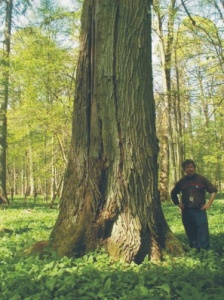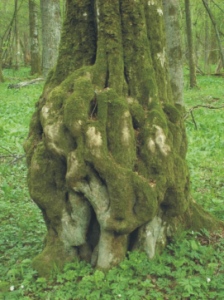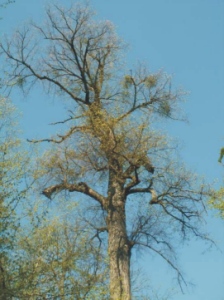
|
WYCH ELM (Ulmus glabra)
Elm belongs to rare tree species in the Bialowieza Forest.
There are three elm species occuring in Poland and most frequent
is the Wych Elm- also called the Scotch Elm. The other two are: the
Field Elm & the European White Elm. All three species are typical of
moist, fertile habitats but it happens that individual elms grow in fresh
forests. In the Bialowieza Forest, alike in the whole world, elms are decimated
by so called ‘the Dutch elm disease', in other words: graphiosa(the name comes
from fungus causing the disease- graphium ulmi). Once in the Bialowieza
National Park there used to grow the Wych Elms with trunk perimeter reaching
500cm.
 Nowadays the thickest elms have perimeters of 450cm and their
maximum height is 33-34 meters(in some sources the height of 37m is given).
Field elms & European elms do not exceed 280cm in trunk perimeter and 30
meters in height.
Nowadays the thickest elms have perimeters of 450cm and their
maximum height is 33-34 meters(in some sources the height of 37m is given).
Field elms & European elms do not exceed 280cm in trunk perimeter and 30
meters in height. BLACK ALDER (Alnus glutinosa)
Alder occurs mainly in alder-ash riparian forests & alder
groves where it forms singlespecies forest. Particularly admired
are soaring alder trunks ended with a small crown. According to some
sources the Bialowieza alders grow up to 40 meters in height with trunk
perimeter( at the height of 130cm) exceeding 300cm. It is difficult for me
to take a stance on the information concerning the trunk perimeter of
Bialowieza alders but it seems to me that the height given is a bit overstated.
MAPLE (Acer platanoides)
Białowieza maples are enormous trees. Especially their trunks
densely covered with moss catch everybody's eyes. They grow mainly
in fresh forests. The heights of maples' trunk pillars reach 20 meters
and the total tree height might be even 37m.
 I measured myself one of maples growing in the National Park.
Its height was 37m with the trunk perimeter(at the height of 130cm)
reaching 380cm what confirms the information included in literature
applying to this subject. Crowns of the Bialowieza maples look extremely
beautiful in spring when their yellow and green colours sparkle in the sun.
I measured myself one of maples growing in the National Park.
Its height was 37m with the trunk perimeter(at the height of 130cm)
reaching 380cm what confirms the information included in literature
applying to this subject. Crowns of the Bialowieza maples look extremely
beautiful in spring when their yellow and green colours sparkle in the sun. COMMON HORNBEAM (Carpinus betulus)
Crowns of the Bialowieza hornbeams form a characteristic roof of the forest.
Regarding habit the hornbeam is the most diverse Bialowieza tree. Crowns
& trunks of the local hornbeams take on extraordinary shapes
 As for size hornbeams are no match for other trees. It sometimes happens
that in the Bialowieza Forest hornbeams reach 30 meters in height with the
trunk perimeter(at the height of 130cm) of 300cm.
As for size hornbeams are no match for other trees. It sometimes happens
that in the Bialowieza Forest hornbeams reach 30 meters in height with the
trunk perimeter(at the height of 130cm) of 300cm.
ASPEN (Populus tremula)
Aspen is one of two specimen of poplar type in the forest flora.
According to literature the biggest aspens grow up even to 40 meters and
reach 300cm in the trunk perimeter(at the height of 130cm) with the age of
180 years.
BIRCH
In the Bialowieza Forest there occur 4 birch species:
silver birch, downy birch, betula humilis schrank and carpatia.
The silver birch reaches the biggest sizes: up to 30 meters high
and about 300cm in trunk perimeter; a bit smaller is the downy birch:
up to 30 m high and about 230cm in trunk perimeter(at the height of 130cm).

WILLOWS
In the Bialowieza Forest there are 15 willow species
but none of them reaches monumental sizes and they occur
mainly in the forest rivers valleys.
SILVER FIR (Abies alba)
Firs occur only in Belarussian part of the Bialowieza Forest-in
the natural reserves: Cisówka and Hubar. Most scientists assume that
those positions are of natural origin.
EUROPEAN YEW (Taxus baccata)
At present wild Yews do not occur in the Bialowieza Forest.
Once Yews used to have their own position in the natural reserve
Nieznanowo, where towards the end of XIX century there grew two small bushes.
After the World War I searching for Yew in the area of Nieznanowo was not
successful.
|